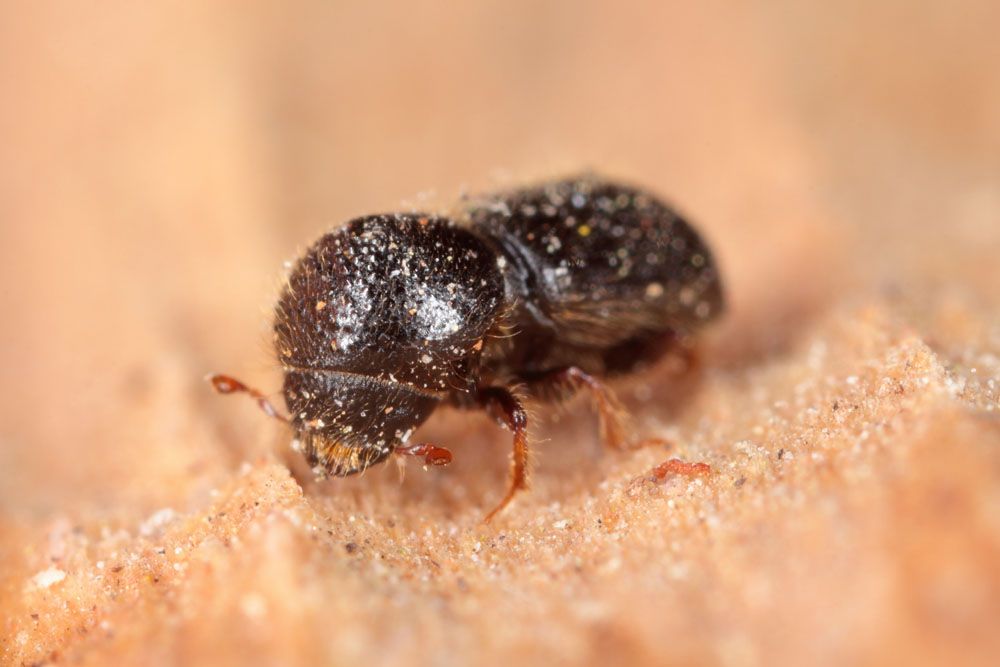
Ambrosia Beetles
Ambrosia Beetles (Xyleborus affinis)
Latin Name: Xyleborus affinis
Common Name: Ambrosia Beetles
Appearance:
Eggs:
The off-white, rectangular, glossy eggs are 0.6 to 1.0 mm in length, with an average of 0.718 mm. Eggs are placed in groups of two to four along horizontal tunnels that branch out from the main vertical tubes. Females have been observed to deposit eggs as early as three days after being introduced into the host and as late as 27 days. (One female can lay several dozen eggs, but the number of eggs (and hence larvae) in an individual gallery can be larger because daughters frequently lay eggs there.
Larva:
Larvae are white, without legs, and somewhat curled. At 29°C, larvae hatch in 7-14 days, while at 22-24°C, they hatch in 14-35 days. They only eat the cultured fungus symbiont that lines the galleries.
Pupae:
The originally white pupae become light brown soon before adult emergence, and male and female pupae average 2.0 and 2.7 mm in length, respectively. Pupation takes 11-23 days at 29°C and 21-35 days at 22-24° C. Adults emerge in 18-35 days at 29 degrees Celsius and 27-35 days at 22-24 degrees Celsius.
Adults:
Female beetles burrow into the trunks and branches of young trees (1.0-2.5 inches in diameter) and excavate tunnels in the heartwood. Female beetles inoculate trees with ambrosia fungus, which can clog xylem arteries and interfere with vascular transit and burrowing damage. Boring can allow harmful fungi such as Fusarium spp. to enter the environment. Infested nursery stock usually dies or becomes unmarketable, and it should be destroyed or chipped to avoid the emergence of new adults. Trees growing in soil or meia with more than 30% moisture content are the most vulnerable. Landscape trees may withstand attacks, but dieback should be monitored and removed if required.
Host plants:
Most western conifers
Territory:
Africa, Asia, Australia, Europe, and the Pacific Islands, including Hawaii, are habitats to Xyleborus affinisis. It is also found in the Antilles, Belize, Costa Rica, El Salvador, Guatemala, Honduras, Mexico, Nicaragua, Panama, and Argentina. It is found in North America from Michigan to Florida and as far west as Texas.
Damage caused by Ambrosia Beetles:
Female beetles burrow into the trunks and branches of young trees (1.0-2.5 inches in diameter) and excavate tunnels in the heartwood. Female beetles inoculate trees with ambrosia fungus, which can clog xylem arteries and interfere with vascular transit and burrowing damage. Boring can allow harmful fungi such as Fusarium spp. to enter the environment. Infested nursery stock usually dies or becomes unmarketable, and it should be destroyed or chipped to avoid the emergence of new adults. Trees growing in soil or meia with more than 30% moisture content are the most vulnerable. Landscape trees may withstand attacks, but dieback should be monitored and removed if required.
Life history and Habits:
Each year, there might be one or more generations. Adult Ambrosia beetles attack from spring through fall, depending on the species. Ambrosia beetles go through the four phases that all bark beetles go through egg, larva, pupa, and adult. Some species overwinter in the wood at all phases, whereas others overwinter as adults in the duff and litter on the forest floor. The majority of species have a pretty broad host range.
